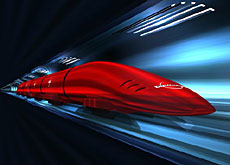
Swissmetro requests new concession

The promoters of Swissmetro, a futuristic underground transportation system using magnetic levitation, have made a new request for a concession between Geneva and Lausanne.
The Swiss government had turned down a similar demand in 1999 because of the lack of proper financial plan.
Swissmetro SA also demonstrated a scale model of its system at a press conference on Friday in Bern, along with a new feasibility study for two pilot tracks.
Described as a cross between a train without wheels and a plane without wings, the Swissmetro scheme has managed to attract new investors despite its slow development. There are now some 200 shareholders, a mixed bag of entrepreneurs, industrial types, government representatives, and individuals.
In 20 years’ time, a new inter-city network might offer a direct link between Lyons and Munich at 600 kilometres per hour, a journey that would just take an hour and 20 minutes to complete, compared to nine and a half hours by train now.
The operational director of the project, Michel Mossi, told Swiss Venture that he hopes to be giving away free tickets for the maiden voyage in 2020.
The biggest obstacle to success promises to be the contruction of the underground network of tunnels that would enable the metro’s passenger vehicles to propel themselves at speeds of at least 500 kilometres per hour in a virtual vacuum.
Natural resources
Mossi says that it would be an opportunity to showcase the country’s “natural resources”, world-class engineering, precision, and inventiveness, especially when it comes to cross-disciplinary high-tech developments.
The Swiss are taking the project step by step, and it will be tested, simulated, probed and analyzed all along the way.
More attention is being paid to marketing and image control this time. A quick look at the web site and the pages of information on market niches, positioning and costs and benefits make that clear.
The next step is the construction of a 20-kilometre test line with a single tunnel. Then a pilot line with two separate tunnels about 100 km in length would be built.
The idea was first put forward back in 1974, by Rodolphe Nieth, a Lausanne-based civil engineer and has had many stops and starts since then.
The long-term perspective, 2030 to 2050, sees the magnetic levitation (maglev) underground as an alternative to medium-haul flights for distances of up to around 1000 kilometres.
The estimated cost of a line connecting Lyons,Munich and Vienna is €40 billion. The exact amount will depend particularly on the maximum speeds authorized, the number of stations and the way they are connected, according to Swissmetro.
Worldwide race
The Japanese, Brazilian, South Korean, and Chinese governments are also funding research and development in similar high-speed maglev systems.
So far the project has been funded by government research grants used by Lausanne’s’ Federal Institute of Technology, and supported by European and Swiss small and medium-sized firms.
Many of the shareholders and project participants are working gratis in the hopes of being able to profit from work contracts once construction gets underway.
by Valerie Thompson

In compliance with the JTI standards
More: SWI swissinfo.ch certified by the Journalism Trust Initiative




























You can find an overview of ongoing debates with our journalists here . Please join us!
If you want to start a conversation about a topic raised in this article or want to report factual errors, email us at english@swissinfo.ch.